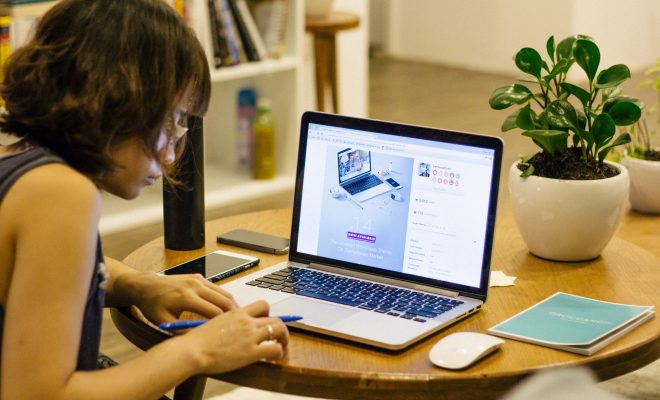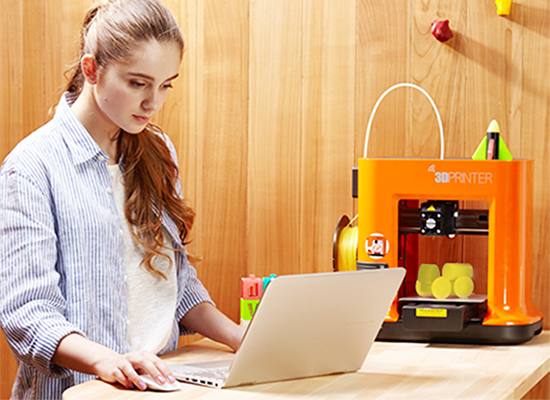Teachers figure out when to turn technology on, and when to turn it off

This summer, nearly 100 new and veteran teachers from the New York City public schools became students themselves. The subject? How to introduce blended learning into their classrooms.
Blended learning combines online and teacher-led instruction. Instead of learning in a traditional, lecture style classroom, students use laptops or tablets to study independently and move through the curriculum at their own pace. But just handing out computers isn’t enough. Successful blended learning requires teachers to know which technology makes the most sense – and when to shut it off.
This fall, teachers are learning to make that distinction in New York City classrooms. After attending summer workshops, they are testing their new skills at making screencasts – online video instruction made up of moving screenshots – and giving students individualized feedback with an application called Autocrat, among other things. These lessons are all part of a training program that is unusual for another reason: It is led entirely by classroom teachers.

iZone mentor Diedre Downing, a math teacher at NYC iSchool in Manhattan, walks Blended Learning Institute participant Juliana Matherson through Google’ Autocrat application on July 18, 2014 in Manhattan. Autocrat lets teachers give custom feedback to students after an online assignment. The New York City Department of Education’s Blended Learning Institute is a two-year training program taught by current classroom teachers on how to use the part digital, part traditional classroom style. (Photo: Alexandria Neason) Photo: Alexandria Neason
The Department of Education’s Office of Innovation, also known as the iZone, works with more than 300 schools to find ways to make personalized learning possible for every student. The Blended Learning Institute is a two-year professional development program that iZone created last year in response to teacher demand for training that would show them how to use technology to convey content – and to help students teach themselves.
Blended learning, sometimes called personalized learning, allows students to work both independently and collaboratively, to start learning at their own level and to advance through the curriculum at their own pace. In a blended learning math classroom, for example, some students might be learning how to solve quadratic equations on computers by themselves, while the teacher works with a small group to plot linear equations on a graph.
“Students might be auditory learners, visual learners, or they learn better on the computer, or they learn better in groups,” said Sharon Holliday, a BLI “student” who runs the computer lab at the Stanley Eugene Clark School in Flatbush, Brooklyn. “Some kids might not be as outspoken in a whole classroom setting.”
In blended classrooms, teachers can move around the room, giving feedback and tailored, personalized support to struggling students.
Related: Computer tutors that can read students’ emotions
“It allows for everyone to learn the way that they feel comfortable, but it also gives the teacher more freedom that might not be possible in a whole group setting,” said Holliday.
While some teachers agree that personalized learning is the goal for all students, in New York City, only a small fraction are using blended learning. This year, the BLI will train just under 100 teachers, which is a small number for a city with more than 1,800 public schools. Still, teachers say that implementing blended learning is necessary for students who already conduct much of their lives online.

Veteran teachers attend a Blended Learning Institute workshop on July 18, 2014 in Manhattan. The Blended Learning Institute, a New York City Department of Education initiative, helps teachers transition to blended learning, a joint digital and direct instruction classroom model. (Photo: Alexandria Neason)
“Blended learning is not about getting devices in front of students,” said Seth Schoenfeld, the iZone’s deputy chief of innovation. “It’s about making the right decisions about when technology makes sense. It’s about how, when, and why to use it.”
Related: What it actually takes for schools to ‘go digital’
The program, a two-year series of workshops, pairs mentor teachers who already use blended learning with teachers trying to make the switch. Schoenfeld says this model — teachers leading teachers — is something they didn’t see happening elsewhere as they designed the program. Other districts offered training by district officials or by outside consultants.
“We truly believe in New York City teachers,” he said. “Why look outside of an organization that has 75,000 teachers available for us to tap into as a resource?”
In 2013, 30 new teachers, all members of the New York City Teaching Fellows, formed the inaugural cohort. This year, the BLI accepted 30 additional first-year teachers, as well as nearly 60 veteran teachers. They’re grouped loosely by grade level and subject, and meet monthly with iZone mentors. All the iZone mentors teach their own blended classrooms.
During the summer, the goal was for teachers to start learning how to use specific technology and blend it with instructional strategies they already use. The transition from a traditional to a blended classroom must happen in steps, according to mentor Krupitsky, who teaches special education at William Alexander Middle School (M.S. 51) in Brooklyn.
Related: Are iPads or Chromebooks better for schools?
Since BLI teachers work in schools with varying levels of access to technology, the key is to start small and be willing to make adjustments, according to Krupitsky.
“All of the teachers are creating something called a unit zero,” he said. “It’s an attempt at your basic, start-of-the-year lesson. It’s really about setting up the framework.”
A “unit zero” lesson helps teachers begin to introduce the blended classroom style to students. This lesson could be related to content, like how to find the main idea in a reading passage, or it could be a technical skill, like how to use Google Docs, that students will need to function in a blended learning environment. The goal is for teachers to have designed a custom blended learning model for their classroom by the end of the two years.
Krupitsky and the other mentors will spend this school year helping their teachers to develop a curriculum, create assessments, and build student engagement, as they phase in blended learning.
For Melanie Buchanan, a first-year teacher at the Bronx Studio School for Artists and Writers, this means designing a blended learning plan that will work for a classroom with limited access to shared computer labs.
“It’s going to be a little bit more challenging than schools that do have iPads and technology for their kids,” she said.

Meg Ray, a computer science teacher at Bronx Compass High School in the Bronx, creates video lessons for her computer science students at the New York City Department of Education’s Blended Learning Institute on July 18, 2014. The Blended Learning Institute guides teachers through a two year transition to blended learning, a joint digital and direct instruction classroom model. (Photo: Alexandria Neason)
Last year, Meg Ray, a computer science teacher at Bronx Compass High School, used blended learning to teach five-week units on digital literacy and computer programming, after observing other teachers in her school. Students at her school have access to a laptop in every class, so she put lessons on a class website for them to go through at their own pace and set up stations for small group work.
“I was never able to get them to independently use the website to go through the lesson,” said Ray. “The biggest struggle was helping the students transition to setting their own goals for getting work done in class.”
This year, she’ll spend the first month of the year teaching her “unit zero,” which will include beginning computer science lessons and procedures to help wean students off the lecture-style instruction they’re used to.
Teachers will get feedback and coaching at monthly check-ins with their mentors, some in person and some digitally. Schoenfeld says the program itself is built to mimic blended learning. “There are workshops and face-to-face, but also a number of online courses that take place through the year,” he said.
Related: Why a New Jersey school district decided giving laptops to students is a terrible idea
Every participating teacher will learn the basics of blended instructional practices, blended learning curriculum choices (iZone schools have access to 17 curriculum catalogs at reduced costs), and how to assess students who are working at different levels. They can call on their mentors for help at any time during the year, as challenges arise. Research says that teacher practice is more likely to change when teachers have a coach to help them throughout the year as they try out new strategies. And educators who are currently in the classroom may be better able to relate to the inevitable obstacles that occur when teachers try new things in the classroom.
“Education is filled with people who can’t do the things they tell teachers to do,” said Krupitsky. “These people have been out of the classroom for five to 10 years, and they have no idea what teachers on the ground are facing.”
Learning from other teachers is a more popular model among teacher participants.
“I like learning from other teachers because they are in the classroom and can present to you from that perspective, as opposed to an outside consultant that might not have a true understanding of what takes place in the classroom,” said Holliday.
Guidance from a mentor teacher can help teachers avoid making common mistakes.
“I would really like my classroom to go paperless, and my mentor is paperless in her classroom, so I can ask her what the logistics are of doing this,” said Buchanan. “It’s very nice to be able to have someone who has done it and can say, ‘that’s not going to work’.”
When executed well, some studies have shown that blended learning can improve student achievement. But how do we know if teachers are being trained well?
For now, the iZone is relying on teacher feedback to find out whether the program is working.

Sharon Holliday, a computer lab teacher at the Stanley Eugene Clark School in Brooklyn, creates a video lesson at the New York City Department Of Education’s Blended Learning Institute summer workshop on July 18, 2014. The Blended Learning Institute is a two year training program taught by classroom teachers on the mixed digital and traditional classroom model. (Photo: Alexandria Neason)
Teachers liked sharing their professional experiences with other teachers, so this year, the BLI increased the opportunities for in-person and online collaboration. Last year, teachers spent two weeks working with a teacher in a blended learning classroom as part of the program, and said that it was key to their development throughout the year. Earlier this year, the BLI offered a 10-week immersion option for the New York City Teaching Fellows before they got into their own classrooms this fall.
“A lot of the feedback we’re getting is a resounding ‘yes’ and support for the workshops and programs as it is,” said Schoenfeld.
But Krupitsky, the mentor teacher, has some suggestions.
He thinks the program should explicitly group mentors with teachers by grade level and subject area. He’s spent most of his career teaching middle school, and says he might not be able to help the few high school teachers in his group with certain issues.
And despite teachers’ hectic schedules at the start of the year, he says monthly check-ins should be done in person, all the time.
“Otherwise things get lost in the shuffle,” Krupitsky said. “No matter how dedicated these teachers are, I can certainly see the BLI commitment being buried at the end of their list.”
Dan Babauta, a mentor, wonders whether the BLI should devote more time to helping teachers learn why they should use the technology or to training them in actually using the devices, applications, and programs needed for blended learning.
“A lot of the procedural skills that a teacher would want to know how to do, like how to screencast a video, you could just go on YouTube and learn about on your own,” said Babauta, who teaches science at Sunset Park High School in Brooklyn. But some teachers may not see the value in BLI’s heavy focus on recognizing when technology is the answer and when it isn’t, according to Babauta.
“Some teachers in the program are going to end up thinking that’s a weakness because they want more hands-on,” he said. “That’s going to be something to revisit at the end of the year.”
The Department of Education has not yet announced an overall strategic goal for getting blended learning into more classrooms. In the meantime, Britt Neuhaus, who heads the BLI, says teachers are gearing up for the challenges – and rewards – of trying new things in their classrooms.
“This is a daunting challenge,” she said. “While there is no magic bullet, we have seen the great potential when a teacher effectively blends their instruction with the smart-use of online content, tools, and assessments.”
Reproduction of this story is not permitted.
This story was written by The Hechinger Report, a nonprofit, independent news website focused on inequality and innovation in education. Read more about blended learning.






